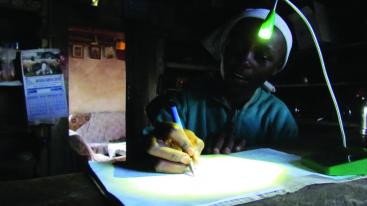
Solar Reading Lights
Purpose-Built Solar Reading Light Designed at UC Santa Barbara
1 billion people do not have direct access to electricity and rely on kerosene, candles or firewood for lighting. Lack of suitable home lighting is directly linked to illiteracy, poverty and health problems. Too many children are burned or impacted by house fires linked to lighting. Lighting should be safe, clean and affordable to all.
Unite to Light started with a visit from Ghanaians Pastor Kofi Fosuhene and Osei Darkwa to Santa Barbara. They explained that many people in Africa, who rely on kerosene for reading, suffer health problems and financial hardship. Aware of the work done at UCSB's Institute for Energy Efficiency on high-efficiency LED lights and high-efficiency solar cells, Fosuhene and Darkwa asked if the Institute could design an affordable reading light. Although many solar powered flashlights are available, they were interested in reading lights because of the problems related to children and education, a focus for both men. With assistance from Engineers without Borders, John Bowers, David Schmidt, Norm Gardner and Jock Bovington set about to solve this problem. After going through several designs, the first samples were sent to Ghana in 2010 and met with great enthusiasm. Unite to Light was then formed as an independent not-for-profit to maintain manufacturing and distribution.
As of summer 2018, Unite to Light has distributed over 100,000 solar lights and solar chargers to people in 70 countries. They focus on helping children learn to read, providing tools for midwives in remote villages, and aiding victims of disasters.
For more information visit the Unite to Light website.
This video shows the impact of the solar lights on students in South Africa.